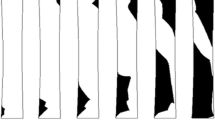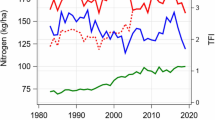Abstract
The relationships between yield loss and incidence (% plants with stems affected) or severity (mean stem score, 0–4 scale) of stem canker in winter oilseed rape were analysed using data from experiments at Rothamsted in 1991/92, Withington in 1992/93, Boxworth in 1993/94 and Rothamsted in 1997/98. Critical point models and area under disease progress curve (AUDPC) models were better than multiple point models for describing relationships between yield (t ha−1) and incidence or severity of stem canker for the four experiments. Since yield is influenced by many factors other than disease, % yield loss was calculated and critical point models and AUDPC models relating % yield loss to stem canker were constructed. The critical point models for % yield loss on stem canker incidence for three of the four experiments were similar, but differed from that for Rothamsted in 1991/92. There were also no differences between models of % yield loss on AUDPC of both incidence and severity for these three experiments. Therefore, general models of % yield loss (L) against AUDPC of incidence (X) or severity (S) of stem canker from growth stages 4.8 to 6.4 were derived from the combined data sets for the three experiments: L=−0.76+0.0075X (R2=35%, p<0.001), L=0.26+0.53S (R2=37%, p<0.001). The relationships between % yield loss and % plants with different stem canker severity scores at different growth stages were also analysed; the greatest yield losses were generally associated with the largest severity scores, for plants assessed at the same crop growth stage, and were also associated with the early development of stem lesions. Further analyses showed that % yield loss was related to incidence or severity of both basal stem cankers and upper stem lesions in experiments at Boxworth in 1993/94 and at Rothamsted in 1997/98.
Similar content being viewed by others
References
Anonymous (1995,1998) Oilseed variety handbook. National Institute of Agricultural Botany, Cambridge
Barbetti MJ (1975) Effects of temperature on development and progression in rape of crown canker caused by Leptosphaeria maculans. Australian Journal of Experimental Agriculture and Animal Husbandry 15: 705-708
Burleigh JR, Roelfs AP and Eversmeyer MG (1972) Estimating damage to wheat caused by Puccinia recondita tritici. Phytopathology 62: 944-946
Campbell L and Madden LV (1990) Introduction to Plant Disease Epidemiology. John Wiley and Sons Inc, New York
Church VJ and Fitt BDL (1995) Incidence and effects of diseases on seven winter oilseed rape cultivars in 1991/92 and 1992/93. International Organization for Biological Control Bulletin 18: 62-68
Fitt BDL, Gladders P, Turner JA, Sutherland KG, Welham SJ and Davies JML (1997) Prospects for developing a forecasting scheme to optimise use of fungicides for disease control on winter oilseed rape in the UK. Aspects of Applied Biology, Optimising Pesticide Applications 48: 135-142
Gabrielson RL (1983) Blackleg disease of crucifers caused by Leptosphaeria maculans (Phoma lingam) and its control. Seed Science and Technology 11: 749-780
Gladders P (1988) The contributions and value of pesticides to disease control in combinable break crops. In: Clifford BC and Lester E (ed) Control of Plant Diseases: Cost and Benefits (pp 29-50). Blackwell Scientific Publications, Oxford
Gladders P and Musa TM (1979) The development of Leptosphaeria maculans in winter oilseed rape and its implications for disease control. In: Proceedings 1979 British Crop Protection Conference-Pests and Diseases (pp 129-136)
Gladders P and Symonds BV (1995) Occurrence of canker (Leptosphaeria maculans) in winter oilseed rape in eastern England 1977–1993. International Organisation for Biological Control Bulletin 18: 1-11
Gladders P, Symonds BV, Hardwick NV and Sansford CE (1998) Opportunities to control canker (Leptosphaeria maculans) in winter oilseed rape by improved spray timing. International Organization for Biological Control Bulletin 21: 111-120
Gugel RK and Petrie GA (1992) History, occurrence, impact, and control of blackleg of rapeseed. Canadian Journal of Plant Pathology 14: 36-45
Hall R, Peters RD and Assabgui RA (1993) Occurrence and impact of blackleg on oilseed rape in Ontario. Canadian Journal of Plant Pathology 15: 305-313
Hammond KE, Lewis BG and Musa TM (1985) A systemic pathway in the infection of oilseed rape plants by Leptosphaeria maculans. Plant Pathology 34: 557-565
Hardwick NV, Culshaw FA, Davies JML, Gladders P, Hawkins JH and Slawson DD (1989) Incidence and severity of fungal diseases of winter oilseed rape in England and Wales, 1986–1988. Aspects of Applied Biology, Production and Protection of Oilseed Rape and other Brassica Crops, 23: 383-392
James WC (1974) Assessment of plant diseases and losses. Annual Review of Phytopathology 12: 27-48
James WC, Shih CS, Hodgson WA and Callbeck LC (1972) The quantitative relationship between late blight of potato and loss in tuber yield. Phytopathology 62: 92-96
Lacoste L, Louvet J, Anselme C, Alabouvette C, Brunin B and Pierre JG (1969) Rôle de Phoma lingam (Tode) Desm. et de sa forme parfaite, Leptosphaeria maculans (Desm.) Ces. et de Not. dans les épidémies de nécrose du collet de colza (Brassica napus L. var. oleifera Metzer). Comptes Rendus de l'Academie d'Agriculture de France 55: 981-987
Lim LG and Gaunt RE (1986) The effect of powdery mildew (Erysiphe graminis f. sp. hordei) and leaf rust (Puccinia hordei) on spring barley in New Zealand. I. Epidemic development, green leaf area and yield. Plant Pathology 35: 44-53
McGee DC and Emmett RW (1977) Blackleg (Leptosphaeria maculans (Desm.) Ces. et de Not.) of rapeseed in Victoria: crop losses and factors which affect disease severity. Australian Journal of Agricultural Research 28: 47-51
Paul VH and Rawlinson CJ (1992) Diseases and pests of rape. Verlag Theodore Mann, Gelsenkirchen-Buer, Germany
Payne RW, Lane PW, Baird DB, Gilmour AR, Harding SA, Morgan GW, Murray DA, Thompson R, Todd AD, Tunnicliffe Wilson G, Webster R and Welham SJ (1993) Genstat 5, Release 3, Reference Manual. Clarendon Press, Oxford
Petrie GA (1979) Blackleg of rape. Canadian Agriculture 24: 22-25
Pierre JG, Regnault Y, Peres A, Penot P, Bonnet T, Thoral N and Tiberghien G (1982) Contribution à la mise au point d'une méthode de plein champ destinée à mesurer la sensibilité des variétés de colza au Phoma. Informations Techniques, Centre Technique Interprofessionnel des Oléagineux Métropolitains 81: 3-18
Rempel CB, Lisieczko Z and Hall R (1991) Epidemiological aspects of resistance in rapeseed to blackleg. In: Proceedings of the Eighth International Rapeseed Congress, Vol 2 (pp 460-464) Saskatoon, Saskatchewan
Roy N (1978) Wesreo — a blackleg resistant rape seed. Journal of Agriculture, Western Australia 19: 42
Sansford CE, Fitt BDL, Gladders P, Lockley KD and Sutherland KG (1996) Oilseed rape: disease development, forecasting and yield loss relationships. Home-Grown Cereals Authority Project Report OS17. 185 pp
Sylvester-Bradley R and Makepeace RJ (1985) Revision of a code for stages of development in oilseed rape (Brassica napus L.). Aspects of Applied Biology, Field Methods and Data Handling, 10: 395-400
Tiberghien G (1974) Étude de l'efficacité de quelques fongicides contre Leptosphaeria maculans (Desm.) Ces. et de Not.: agent de la nécrose du collet du colza. Mémoire de fin d'études, Institute Supérieur d'Agriculture de Lille, Centre Technique Interprofessionnel des Oléagineux Métropolitains. 68 pp
Van der Spek J (1981) Blackleg of oilseed rape in Netherlands. Medelelingen van de Faculteit Landbouwwetenschappen Rijksuniversiteit Gent 46: 813-822
Author information
Authors and Affiliations
Corresponding author
Rights and permissions
About this article
Cite this article
Zhou, Y., Fitt, B., Welham, S. et al. Effects of Severity and Timing of Stem Canker (Leptosphaeria maculans) Symptoms on Yield of Winter Oilseed Rape (Brassica napus) in the UK. European Journal of Plant Pathology 105, 715–728 (1999). https://doi.org/10.1023/A:1008761219493
Issue Date:
DOI: https://doi.org/10.1023/A:1008761219493




